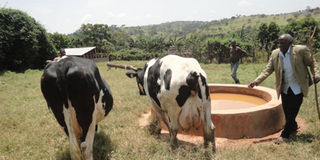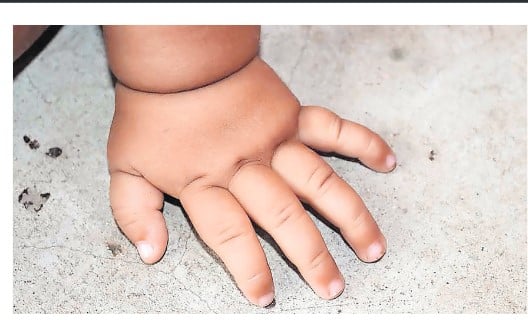Prime
He started mixed farming with just 10 cows

A dairy farmer attends to his cows. Photo by Otushabire Tibyangye
What you need to know:
Modern farming entails adapting to new technologies, applying good practices, information sharing, among others. Yonasani Kashaija, 74, understood this when he migrated from Buganda to Ankole. He told Otushabire Tibyangye his story
I decided to migrate from Bulemeezi in Buganda to Nyabushozi, Ankole, in 1963 so I could practise mixed farming although my background is cattle keeping.
One of the reasons why I settled here was to have enough land for both keeping cattle and growing cash crops such as coffee and tea, and other food crops such as bananas.
My target was to produce milk alongside other crops. When I came to this village, Kyejo in present-day Kazo county, I had only 10 heads of cattle. They were local breeds.
I had not gone far with education having finished the equivalent of Primary Four in 1950, but was focused on what I wanted in life.
Banana growing

Kashaija shows an award he won as best farmer in the county and district.
I immediately established a banana plantation of two acres to feed my family and give to my neighbours who were few at that time.
I eventually acquired 200 acres of land where my farm currently is. The money was from the sale of beans and chicken. I have always grown beans, which helped me raise capital for labour.
I started with an acre of beans and kept expanding it up to 10 acres. As I planted beans, I would use the same land for bananas. At times, I harvest about 100 bags of beans a season.
Currently, there are 10 acres of bananas intercropped with paw paws where I harvest 300 bunches and earn between Shs2m-Shs3m depending on the season. I sell most of the bananas to traders, who come from Mubende, and few to locals in the village.
Later I planted two acres of eucalyptus trees to provide poles for use on my farm. This forest has not only provided poles for my farm, but have also become a source of revenue.
I have established a pole treatment plant, from which I earn up to Shs2m depending on the demand. With the demand for electricity poles, I have also planted two more acres of trees, which are about to mature.
Dairy animals

A dairy farmer attends to his cows. Photo by Otushabire Tibyangye
In 1973, I visited dairy farmers in Bushenyi District and found that they had introduced exotic animals. When I came back to my farm, I was determined to change my animals too.
I bought a bull from there and since then I have completely done away with the local breeds, whose number had come up to about 200. I now keep 80 cows, which are improved breeds, that produce 200 litres of milk a day.
I fenced off the land and put paddocks in place to control disease through ticks from other animals, wastage of pastures and also to reduce costs of labour.
I have also improved the pastures by planting Rhodes grass, Calliandra and Napier grass for supplementary feeding of lactating cows.
I have also introduced zero grazing for animals that give higher yields.
There are four such animals, which among them yield 60 litres of milk per day.
I have a “sick bay” where the animals are treated expecially those that fail to deliver and those that need extra attention.
This sickbay has saved four animals, which had complications during delivery. They delivered calves via Caesarean section just like how human beings can be operated on.
Orchard

Kashaija shows the pawpaws, which are part of an orchard that also has mangoes and avocados.
I realised that I could enhance my earnings with fruit trees: Avocadoes, mangoes, oranges, apples and pawpaws. To this, I added pineapples.
I took advantage of animal manure to improve the crops. I use cow dung as fertiliser for the bananas, fruits and cabbages. I earn Shs2m from oranges, mangoes and avocadoes.
Record keeping
Record keeping has been at the centre of his success. Every section on the farm has a book, which shows production, income, expenditure, inputs and total earnings.
I learnt this from agricultural extension service providers, with whom I am in constant touch with. I pay for their services since government does not provide them.
These service providers teach me how to profit from my investments and also good farming practices. However, they are very expensive to maintain but the overall benefit is more than money.
I attribute my success to Prof Elly Sabiti, who was at Makerere University. When he visited me, he inspired me to reach the level where I am.
Achievements
Paying school fees. I was able to pay for the education of my six children up to university.
House and farm. I have also built a modern house. I use biogas for both lighting and cooking and the slurry for fertiliser. I have turned my farm into a learning centre where farmers are taught good agronomic practices.
Recognition. I won three awards for being the best farmer in Kazo county and Kiruhura District respectively.
Tackling challenges. Like most farmers, I face challenges of price fluctuations and post-harvest wastage as well as the disadvantages of rain-fed agriculture. I have taken steps to reduce some of these bottlenecks. I keep a manageable herd, use improved seeds and animal breeds.
For workers’ retention, I pay them well, give them incentives like housing and food, and I look after them as part of my family.
Lessons
Yonasani Kashaija emphasises that most of the developments that he is engaged in are out of personal interests and copying the best from friends and fellow farmers far and wide.
To do this, he has visted various farmers from other areas within the Ankole region.
As dairy farming is his core business, he maintains that to keep healthy animals treatment is very important. Kashaija has a sickbay for his animals that fall sick.
These are isolated in a paddock and those that are badly off have a resting room in the shade, where they are treated and made to rest.




